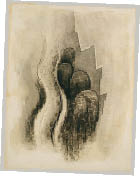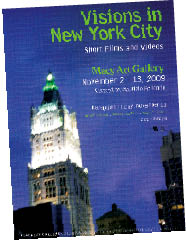Playing to the Gallery
TC's Macy Gallery exerts a powerful influence on artists who show there--and on art education students at the College
By Jonathan Sapers
It has exhibited everything from works by Georgia O’Keeffe to the efforts of preschoolers. It has anchored an art education program that was first chaired by Arthur Wesley Dow and that numbers not only O’Keeffe but also Ad Reinhardt, Agnes Martin, William Daley and Charles Alston among its alumni.
Yet its doorways may best define Macy Gallery, the 1,300-square-foot, fourth-floor space at Teachers College that serves not only as a show and performance venue, but also as a classroom, studio and forum for public discourse.
Art on the walls in Macy’s outside gallery must share space with doors leading into several faculty offices and classrooms in TC’s Program in Art and Art Education. Turn left in the middle of the outside space, and you make your way into a somewhat smaller space that’s also part of Macy Gallery. Beyond this, yet another entrance leads to a still smaller gallery space used for one-person rotating shows.
At her show in September, artist and current TC doctoral student Donna Clovis not only adapted to the doors but also used them to help accentuate different themes in her material. Clovis displayed her photojournalistic work in Macy’s exterior room, pitched to the casual viewer rushing to class. She put her more introspective work in the larger of the two interior rooms—black and white still-lifes that combine objects such as an alarm clock with nude self-portraits in soft focus. Visitors were invited to offer single-word comments on the still-lifes. In the smaller interior room, an LCD screen displayed a story composed from single-word comments written on post-its by viewers at a previous showing.
“The Gallery has always been a symbol of what’s unique about art and art education at TC,” says Judith Burton, head of the art education program and Macy director. “I came to TC because I saw that, more than any other program in the nation, there was a balance of studio practice and art education theory. We ask, ‘How can theory and practice each richly and deeply inform the other?’”
Olga Hubard, Assistant Professor of Art Education, says the Gallery periodically becomes a “living space for work to be created in conversation—with visitors as well.”
Last summer, Macy became both studio and gallery for a group of master’s students and alumni in-service teachers who made art for live audiences. At last spring’s week-long symposium, “Bridging Discourses,” the focus was on the response of artists working in one medium to art from another.
“On opening night we projected two large images of well-known modern paintings,” Hubard says. “A musician and a dancer responded to the paintings through their art and then to each other as well.”
Maurizio Pellegrin, an internationally known artist who serves as an adjunct faculty member, puts it most simply.
“We have thousands of galleries in New York City,” says Pellegrin, who curates two exhibits at Macy each year. “We want to be a little different.”
The Gallery dates back to just before World War I, when O’Keeffe was a student working with Dow. There are some gaps in its known history, but by the time Burton arrived in the late 1980s, the space had been much neglected. Working on a shoestring budget, Burton made it her first priority to organize an exhibition of famous TC-associated artists. She made the rounds of top art galleries and museums, asking if they would lend paintings by all the famous alumni named above, and then some. To her amazement, most said yes.
“Conservatively speaking we had maybe $3 million worth of art on our walls, and the Macy Gallery at that time had no locks on the doors and very little insurance,” Burton says, shaking her head. “It was a month of nightmares for me. Every morning I’d come in expecting to open the doors and find the Gallery walls to be empty. But they weren’t. And huge numbers of people came, which helped to re-center our work around the Gallery once more.”
Other impressive shows have followed that audacious rebirth. In 2004, Burton imported works by Chinese artists from the Central Academy of Fine Arts in Beijing. “I’d been there one summer and was so impressed with the technical quality and also the imaginative interpretation of ideas,” she says. “We had Chinese western oil paintings and Chinese traditional oil paintings, printmaking and watercolor.” The show was another big hit—and, for Burton, another nail-biter. “We brought it all over by ship, and I was concerned. What if the entire show sinks to the bottom of the Pacific Ocean? It took forever to get here, and then they would not release the work from port until I had hired a pre-approved commercial company to transport it to TC.”
Macy was also the venue for the first showing of the drawings for The Gates, the February 2005 project in which the artists Christo and Jeanne-Claude distributed 7,500 free-hanging, saffron-colored fabric panels throughout the footpaths of Central Park. Again, the Gallery was packed, and the artists signed specially designed posters throughout the evening. They subsequently gave TC 20 signed prints of their various wrapping projects—pictures that now hang along the walls of the first floor of Grace Dodge Hall.
Following a trip to Vietnam in 1996, Burton brought three of the country’s up-and-coming lacquer painting artists to TC to show their work and give teaching clinics on their techniques. Huge audiences attended, including the Vietnamese ambassador to the United Nations and both his cultural secretaries, as well as “everyone else who was anybody in the Vietnamese community in New York City.” The three artists who exhibited are now among the most prominent in Vietnam.
Another major exhibition featured the work of Herb Gentry, who along with Romare Bearden and Jacob Lawrence played a significant role in the Harlem Renaissance. Gentry spent a year at TC as a visiting artist, and many of his fellow artists from pre- and post-war Paris came in to share their stories with students. When he died, a collector donated eight of Gentry’s works from his Macy show. The pieces now hang in Room 177 in Grace Dodge.
But Macy was never intended to be solely a big-name venue. Thanks to assistance from the Myers Foundation—endowed by the late Eugene Myers, a TC alumnus (and, later, instructor) who was Dean of the Corcoran School of Art in Washington, D.C.—the Gallery now mounts around 17 exhibitions annually. These include juried shows of work by current students, alumni and international artists. As a “working gallery,” Macy also mounts exhibitions by children, including those in TC’s Rita Gold Center, Bank Street School for Children, Frank Sinatra High School, the Harlem Children’s Zone and the Children’s Art Carnival. The annual spring show pairs the work of TC student teachers with that of schoolchildren they have taught during their field placements.
Thanks to a recent Myers-funded renovation that includes new lighting, a plasma screen and LCD video projectors in each gallery space, as well as the serendipitous discovery of an oak floor under the old linoleum, Macy is increasingly serving as a lab for explorations of visual ideas that are genuinely new and different. Last year, for example, the Gallery hosted “Visions in New York City,” a collection of short films and videos about New York City, including many by TC students and faculty. The show, curated by Pellegrin, was subsequently selected for inclusion at the prestigious Art Basel-Miami Verge Fair. It was such a success that TC has now been ‘invited’ to exhibit there again next year.
The updating of the gallery spaces in recent years has accompanied a growing re-emphasis at TC on the importance of studio classes. Students are now required to spend more time in studio practice of painting, printmaking, sculpture, drawing, ceramics, photography and digital art.
Associate curator Razia Sadik believes the Gallery can reflect this emphasis.
Sadik is designing in-service workshops that draw upon the work of the Gallery and its exhibitions. She currently is planning three weekend opportunities, titled, respectively, Digital Story Telling; Toying with Play: A Puppet and Toy-Making Workshop; and Teaching Portfolio Design for Artist Educators. This last will be provided by Atif Toor, a graphic design and typography expert who designs and develops educational content for the Metropolitan Museum of Art. Toor will work with students on refining their portfolios, including using type to project their individual teaching philosophies. Toor’s workshop will coincide with “Written Spaces: Contemporary Iranian Typography,” an exhibition curated by TC doctoral student Roshanak Keghobadi, who has been researching Iranian typographic art for several years. The results of Keghobadi’s research will be the subject of the first show at Macy in Spring 2011.
For his part, Pellegrin is hoping to organize an exhibition of contemporary and modern design, with pieces by Le Corbusier, Breuer and Castiglioni.
“The students usually sit in chairs and don’t even know the name of one important chair,” he says. “I’m a European, and in my country, the butcher has never been to school, but he knows something about music and theater. Here we give out Ph.D.s to people who sometimes don’t even know who the most important architects are right now.”
To learn more about the Macy Gallery, visit www.tc.edu/macygallery.
Published Tuesday, Dec. 14, 2010












